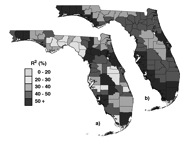home
about me







research
links

"If man's wit be wandering, let him study the mathematics..."
Major Professor: Eric Chassignet
In coordination with: Steve Morey, Felicia Coleman, Kevin Speer, Dmitry Dukhovskoy
Circulation Dynamics & Larval Transport in the FL Big Bend
My PhD research is concerned with determining the physical mechanisms responsible for the onshore transport of gag grouper (Mycteroperca microlepis) larvae in the Northeastern Gulf of Mexico. This reef fish, which is vitally important to both Florida's fishing economy and local ecology, spawns near shelf and shelf-edge reefs (50-100m depth) in the late spring (Feb-Apr). Gag larvae are then transported into the seagrass beds of the Big Bend Region (BBR) of Florida over the course of the next 40-60 days. A high-resolution ROMS model configured for the BBR is developed to study the coastal circulation dynamics and assess the variability of this circulation and its associated transport mechanisms.
My PhD research is concerned with determining the physical mechanisms responsible for the onshore transport of gag grouper (Mycteroperca microlepis) larvae in the Northeastern Gulf of Mexico. This reef fish, which is vitally important to both Florida's fishing economy and local ecology, spawns near shelf and shelf-edge reefs (50-100m depth) in the late spring (Feb-Apr). Gag larvae are then transported into the seagrass beds of the Big Bend Region (BBR) of Florida over the course of the next 40-60 days. A high-resolution ROMS model configured for the BBR is developed to study the coastal circulation dynamics and assess the variability of this circulation and its associated transport mechanisms.
Frontal Structure of the ACC along 30E
In early 2008, I was a student member onboard the R/V Roger Revelle, as part of the CLIVAR I6S research cruise along 30E through the Southern Ocean. Myself and other student members completed an analysis of the frontal structure across the Agulhas basin and the ACC. The horizontal and vertical temperature, salinity, potential vorticity structure and transport are assessed across the I6S line. A second, higher-resolution XBT section was also occupied, from which frontal structure and transport are also analyzed. This work was presented at the 2008 Fall Meeting of the American Geophysical Union.
In early 2008, I was a student member onboard the R/V Roger Revelle, as part of the CLIVAR I6S research cruise along 30E through the Southern Ocean. Myself and other student members completed an analysis of the frontal structure across the Agulhas basin and the ACC. The horizontal and vertical temperature, salinity, potential vorticity structure and transport are assessed across the I6S line. A second, higher-resolution XBT section was also occupied, from which frontal structure and transport are also analyzed. This work was presented at the 2008 Fall Meeting of the American Geophysical Union.



NE Gulf of Mexico Surface Circuation
I was enrolled in a Marine Field Methods course in Spring 2009, which was focused on the surface wind-driven circulation, tides, and bio-physical connectivity in the Northeastern Gulf of Mexico. In this course, we assessed and discussed the different metrics used to measure circulation patterns and mixing, part of which was the design and construction of surface drifters. I prepared some brief model studies using ROMS to obtain an idea of the surface circulation patterns around the time of our cruise (early April, 2009). This model study can be found here.
I was enrolled in a Marine Field Methods course in Spring 2009, which was focused on the surface wind-driven circulation, tides, and bio-physical connectivity in the Northeastern Gulf of Mexico. In this course, we assessed and discussed the different metrics used to measure circulation patterns and mixing, part of which was the design and construction of surface drifters. I prepared some brief model studies using ROMS to obtain an idea of the surface circulation patterns around the time of our cruise (early April, 2009). This model study can be found here.
A Statistical Comparison of Fire Variability and the Keetch- Byram Drought Index across Florida
As a meteorology student at COAPS, I studied the effectiveness of using the Keetch-Byram Drought Index (KBDI) as a wildfire forecasting tool in the state of Florida. With Dr. Dmitry Dukhovskoy and other researchers at COAPS, we were able to develop statistical models to aid in explaining the variability in the number of fires each month across FL using the KBDI as an independent variable. This study is currently in review.
As a meteorology student at COAPS, I studied the effectiveness of using the Keetch-Byram Drought Index (KBDI) as a wildfire forecasting tool in the state of Florida. With Dr. Dmitry Dukhovskoy and other researchers at COAPS, we were able to develop statistical models to aid in explaining the variability in the number of fires each month across FL using the KBDI as an independent variable. This study is currently in review.


